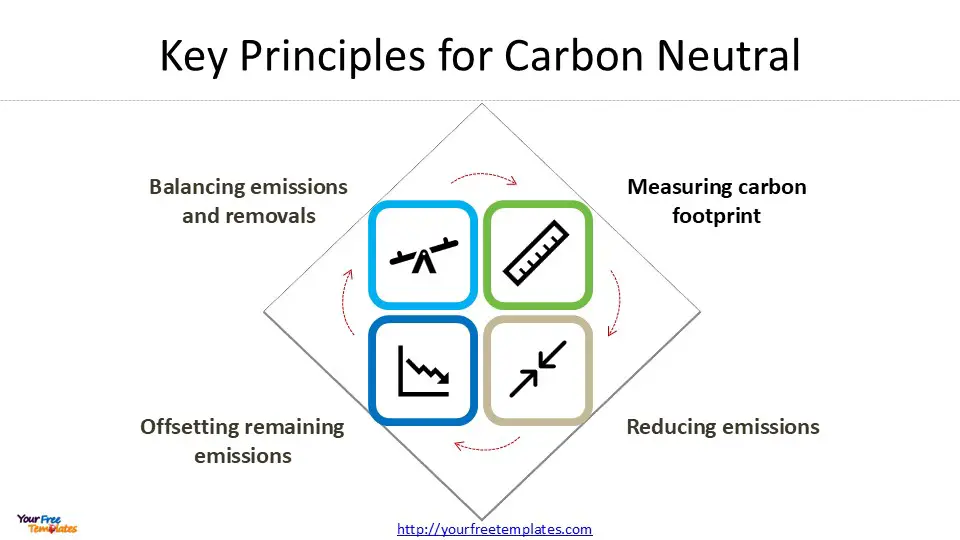In today’s world, the term “carbon neutral” has become increasingly important as society grapples with the challenges of climate change and global warming. Understanding carbon neutral meaning is crucial for individuals, businesses, and governments striving to reduce their environmental impact. This concept has gained significant traction since the Paris Agreement, which aims to limit global temperature rise and promote sustainable practices worldwide.
At the end of this post, you can download our Carbon Neutral Meaning PowerPoint template to fit your purpose. As the same diagram PowerPoint template series, you can also find our Renewable Energy Sources, Generative AI, Circular Economy, Blue Sea Strategy, 2025 Calendar with Holidays, The 7 Habits of Highly Effective People, Six Thinking Hats, Pareto Chart, Occam’s Razor, Data Mining, marketing segment, Porter’s five forces, SWOT Analysis, GE Matrix, BCG Matrix, Artificial Intelligence, National Diamond and BlockChain PowerPoint templates.
Carbon neutrality refers to achieving a balance between carbon emissions and carbon absorption from the atmosphere. It involves measuring one’s carbon footprint, implementing strategies to reduce emissions, and offsetting remaining emissions through various methods. From adopting a carbon neutral lifestyle to pursuing carbon neutral certification, there are numerous ways to contribute to this global effort. This guide will explore the carbon cycle, discuss how to calculate and reduce carbon footprints, and examine the role of carbon credits in achieving a more sustainable future.
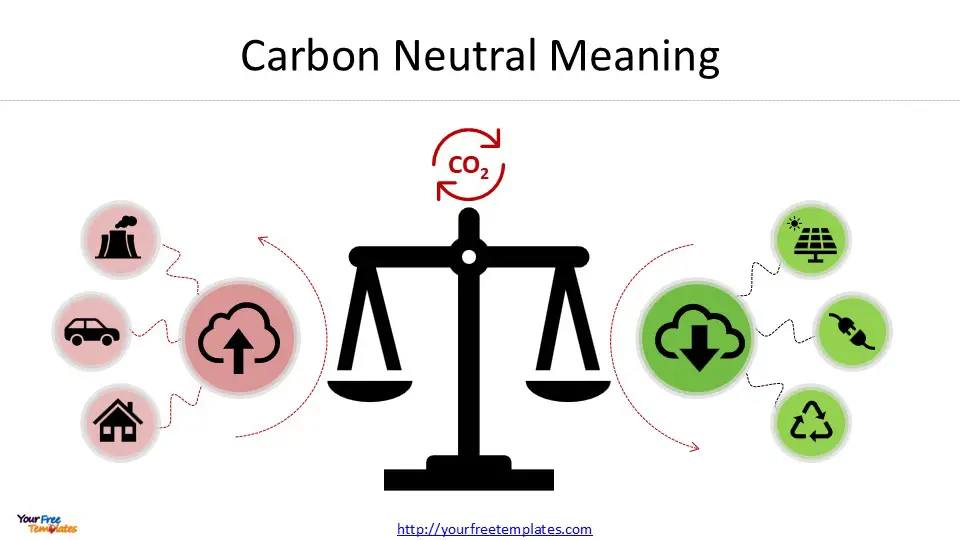
The Carbon Neutrality Concept
The concept of carbon neutrality has gained significant traction in recent years as a crucial strategy to combat climate change and global warming. Carbon neutrality, also known as net-zero carbon emissions, refers to achieving a balance between the amount of carbon dioxide released into the atmosphere and the amount removed or offset 1. This balance is essential to stop the increase of CO2 in the atmosphere, which is a primary driver of global warming.
Origins and development
The idea of carbon neutrality emerged from research conducted in the late 2000s, which explored how the atmosphere, oceans, and carbon cycle were reacting to CO2 emissions 2. This research revealed that global warming would only cease if CO2 emissions were reduced to net zero. The concept gained prominence after the Intergovernmental Panel on Climate Change (IPCC) published its Special Report on Global Warming of 1.5°C in 2018 2. This report emphasized the importance of reaching and sustaining net-zero global anthropogenic CO2 emissions to halt human-caused global warming.
The Paris Agreement, signed by 195 countries in 2015, played a pivotal role in establishing carbon neutrality as a global goal 3. The agreement aims to limit global temperature rise to well below 2°C above pre-industrial levels, preferably to 1.5°C. To achieve this target, the world must reach carbon neutrality by the second half of the 21st century 3.
Key principles
The carbon neutrality concept is built on several key principles:
- Measuring carbon footprint: This involves quantifying the total amount of greenhouse gas emissions produced directly and indirectly by an individual, organization, or country.
- Reducing emissions: Implementing strategies to decrease carbon emissions, such as transitioning to renewable energy sources, improving energy efficiency, and adopting sustainable practices.
- Offsetting remaining emissions: Investing in projects that remove or sequester carbon from the atmosphere, such as reforestation or carbon capture technologies, to compensate for unavoidable emissions.
- Balancing emissions and removals: Achieving a state where the amount of CO2 emitted is equal to or less than the amount removed from the atmosphere.
Global carbon neutrality goals
As of February 2021, 124 countries had pledged to achieve carbon neutrality by 2050 or 2060 4. These commitments represent a remarkable development in the global effort to address climate change. The goal of carbon neutrality by 2050 is to limit the temperature increase by 2100 to 1.5°C–2.0°C from its pre-industrial level 4.
To reach this ambitious target, countries and organizations are implementing various strategies, including:
- Transitioning to renewable energy sources
- Improving energy efficiency in buildings and industries
- Promoting sustainable transportation
- Investing in carbon capture and storage technologies
- Protecting and restoring natural carbon sinks, such as forests and oceans
While the path to carbon neutrality presents challenges, it also offers opportunities for economic growth and technological innovation. The transition to a low-carbon economy has the potential to create millions of new jobs and drive sustainable development worldwide.
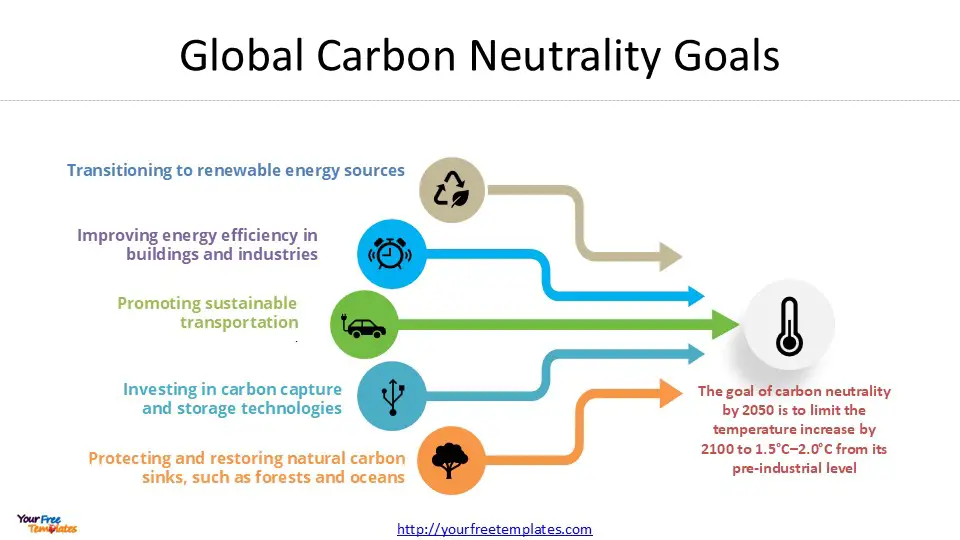
Measuring Carbon Footprint
Measuring carbon footprint is a crucial step in understanding and reducing an organization’s impact on climate change. The process involves quantifying greenhouse gas (GHG) emissions, which are typically measured in carbon dioxide equivalent (CO2e) units. This standardized approach allows for a unified expression of various GHGs’ contributions to global warming.
To accurately measure carbon footprint, organizations must consider emissions across three scopes as defined by the Greenhouse Gas Protocol:
Scope 1, 2, and 3 emissions
Scope 1 emissions are direct emissions from sources owned or controlled by an organization. These include emissions from fuel combustion in company-owned vehicles, on-site energy generation, and fugitive emissions from chemical processes or refrigerant leaks 5.
Scope 2 emissions are indirect emissions resulting from the generation of purchased electricity, steam, heat, and cooling. These emissions occur at the facility where the energy is produced but are attributed to the organization consuming the energy 5.
Scope 3 emissions encompass all other indirect emissions that occur in a company’s value chain. This category is often the largest and most complex to measure, including emissions from purchased goods and services, business travel, employee commuting, waste disposal, and the use of sold products 5.
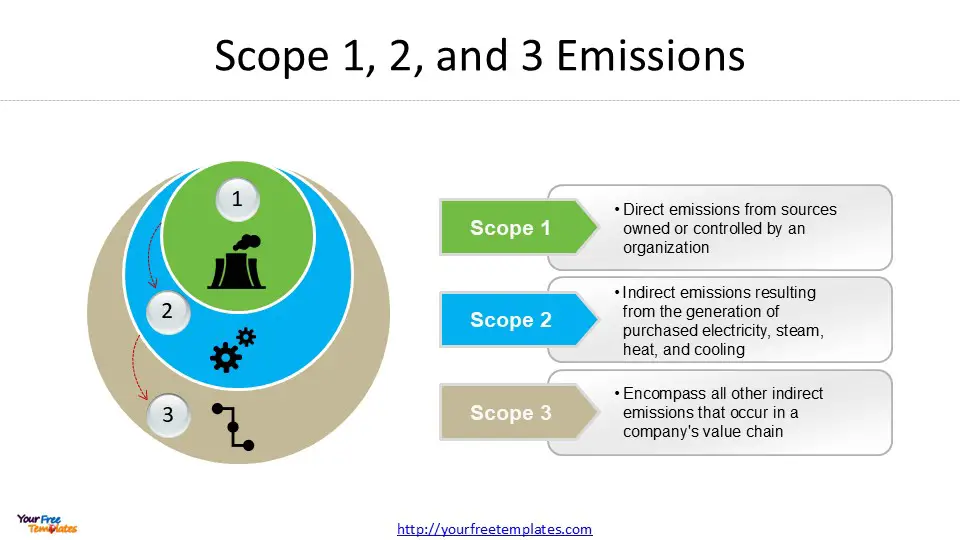
Carbon accounting methods
Several carbon accounting methods are available to organizations for measuring their carbon footprint:
- Spend-based method: This approach estimates emissions based on the economic value of purchased goods and services. It multiplies the monetary value by emission factors, providing a quick but less precise estimate 6.
- Activity-based method: This method measures specific activities like procurement, transportation, and product use. It involves collecting raw data on all business activities and multiplying it by appropriate emission factors, offering more accurate results but requiring more resources 6.
- Hybrid method: This approach combines various methodologies, integrating the best aspects of both activity-based and spend-based methods. It is recommended by the Greenhouse Gas Protocol and is widely used for its balance between accuracy and feasibility 7.
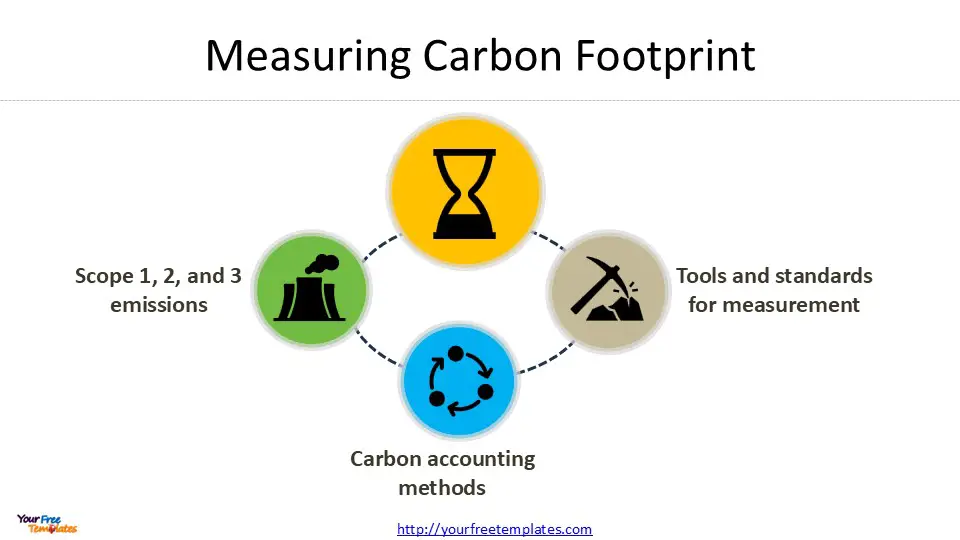
Tools and standards for measurement
Several tools and standards have been developed to assist organizations in measuring their carbon footprint:
- GHG Protocol Corporate Standard: This widely accepted standard provides guidelines for accurate and consistent carbon reporting, covering the measurement of Scope 1, 2, and 3 emissions. It emphasizes five central tenets: relevance, completeness, consistency, transparency, and accuracy 6.
- ISO 14064-1: This international standard outlines the main requirements and principles for quantifying and reporting GHG emissions at the organizational level 8.
- Carbon accounting software: Various software solutions are available to help businesses track GHG emissions, ensure adherence to the greenhouse gas protocol, and measure emissions from various sources 9.
- Industry-specific tools: The GHG Protocol has developed cross-sector, country-specific, and sector-specific tools to address unique emission challenges and regional factors 7.
When selecting a carbon accounting method or tool, organizations should consider factors such as data availability, accuracy requirements, and industry-specific needs. It’s important to note that while measuring Scope 1 and 2 emissions is generally straightforward, quantifying Scope 3 emissions can be more challenging due to the complexity of value chains and data availability.
By accurately measuring their carbon footprint, organizations can identify emission hotspots, set reduction targets, and develop effective strategies to achieve carbon neutrality. This process is essential for businesses striving to contribute to global efforts in combating climate change and meeting the goals set forth in the Paris Agreement.
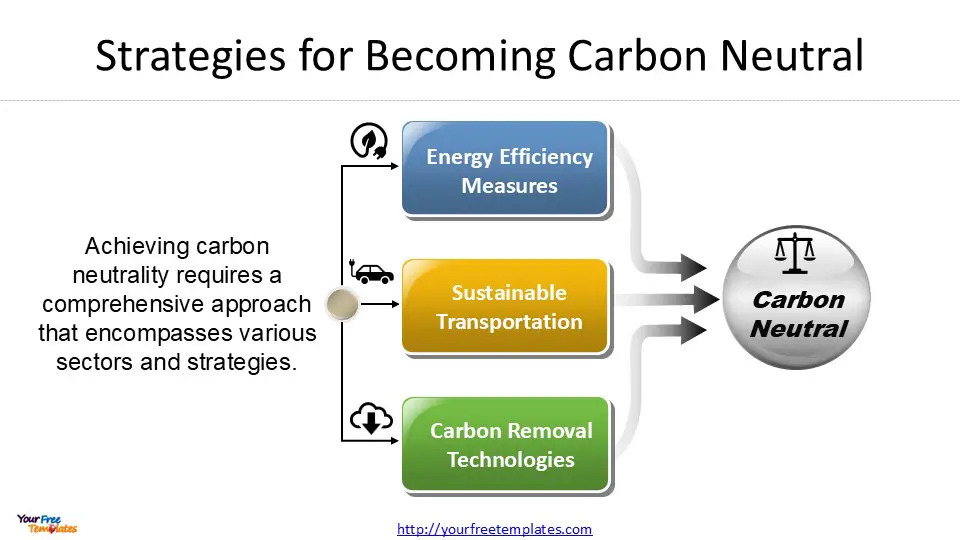
Strategies for Becoming Carbon Neutral
Achieving carbon neutrality requires a comprehensive approach that encompasses various sectors and strategies. To combat climate change and global warming effectively, organizations and individuals must implement a range of measures to reduce their carbon footprint and offset remaining emissions.
Energy efficiency measures
One of the most crucial steps in becoming carbon neutral is to improve energy efficiency. This approach not only reduces greenhouse gas emissions but also leads to significant cost savings. The International Energy Agency (IEA) estimates that energy efficiency improvements could account for more than 40% of the emissions abatement needed by 2040 10. To reach this potential, organizations can implement several strategies:
- Upgrading to energy-efficient equipment and appliances
- Implementing smart building management systems
- Optimizing industrial processes
- Improving insulation in buildings
Digital technologies are playing an increasingly important role in enhancing energy efficiency. These advanced systems can forecast energy demand, improve response capabilities, and limit production and distribution losses 10. By leveraging artificial intelligence and other smart technologies, organizations can potentially improve the efficiency of up to 12% of global electricity consumption 10.
Sustainable transportation
The transportation sector is a major contributor to greenhouse gas emissions, making it a critical area for carbon neutrality efforts. Implementing sustainable transportation strategies can lead to cleaner air, enhanced equity, and other benefits. The Avoid-Shift-Improve (ASI) framework provides a robust approach to decarbonizing transportation 11:
- Avoid unnecessary motorized travel through behavior change programs
- Shift to less carbon-intensive modes of transport
- Improve the energy and carbon efficiency of vehicles
Promoting collective transport, such as trains and ridesharing, and expanding public transport networks can significantly reduce emissions. Additionally, the rapid conversion of the global passenger car fleet to electric vehicles (EVs) is crucial, as EVs are up to five times more efficient than conventional vehicles 11.
The transition to sustainable transportation is becoming increasingly viable, with most low-carbon technologies expected to be economically feasible worldwide by 2030 11. Governments can accelerate this transition by implementing favorable regulatory frameworks, tax incentives, and grants for low-carbon vehicles and charging infrastructure.
Carbon removal technologies
To achieve carbon neutrality, it is essential to not only reduce emissions but also actively remove CO2 from the atmosphere. Carbon removal technologies play a crucial role in this effort, with both natural and technological strategies available 12. Some key carbon removal approaches include:
- Tree restoration and reforestation
- Agricultural soil management
- Direct air capture
- Carbon mineralization
- Biomass carbon removal and storage
- Ocean-based carbon removal
The National Academy of Sciences, Engineering, and Medicine and the Intergovernmental Panel on Climate Change have emphasized the critical role of carbon removal in achieving climate targets by 2050 12. In the United States alone, it is estimated that about 1 billion tons of CO2 per year will need to be removed by midcentury to reach net-zero emissions 12.
Implementing a diverse portfolio of carbon removal solutions provides the most cumulative carbon removal at the lowest risk. This approach creates multiple options for achieving removal targets, should any single pathway fail to realize its expected potential 12.
By adopting these strategies for becoming carbon neutral, organizations and individuals can contribute significantly to the global effort to combat climate change and work towards the goals set forth in the Paris Agreement. As technologies advance and become more cost-effective, the transition to a carbon-neutral future becomes increasingly attainable, paving the way for a more sustainable and resilient world.
Conclusion
Understanding and implementing carbon neutrality has a significant impact on our global efforts to tackle climate change. The journey to achieve net-zero emissions involves measuring carbon footprints, putting energy efficiency measures into action, and exploring sustainable transportation options. What’s more, the development of carbon removal technologies plays a crucial role in offsetting unavoidable emissions and moving towards a more sustainable future.
To wrap up, the path to carbon neutrality offers both challenges and opportunities. By adopting a well-rounded approach that combines emission reduction strategies with carbon offsetting, individuals and organizations can make a real difference. As we continue to innovate and refine our methods, the goal of a carbon-neutral world becomes increasingly achievable, paving the way for a cleaner, more resilient planet for future generations.
FAQs
What is the definition of carbon neutrality?
Carbon neutrality refers to achieving a balance between the carbon emissions produced and the carbon absorbed from the atmosphere by carbon sinks. This process often involves carbon sequestration, which is the capture and long-term storage of carbon dioxide.
How is carbon neutrality legally defined?
Legally, carbon neutrality is defined as having no net release of carbon dioxide into the atmosphere. This commitment was part of the 1992 United Nations Framework Convention on Climate Change, where numerous countries pledged to reduce emissions of carbon dioxide and other greenhouse gasses.
What does it mean for an order to be carbon neutral?
When an order is described as carbon neutral, it typically indicates that the company has engaged with third-party services like Shopify, Stripe, or EcoCart to fund projects that offset or remove carbon emissions associated with the checkout, shipment, or delivery of the item.
What does the carbon neutral rule entail?
The carbon neutral rule aims to reduce human-caused greenhouse gas emissions to zero. Achieving carbon neutrality involves a thorough accounting of all greenhouse gas emissions from every source, followed by implementing measures to reduce these emissions to zero.
Size:313K
Type: PPTX
Carbon Neutral Meaning Template
Click the link to download it.
Aspect Ratio: Standard 4:3
Click the blue button to download it.
Download the 4:3 Template
Aspect Ratio: Widescreen 16:9
Click the green button to download it.
Download the 16:9 Template
References
[1] – https://www.europarl.europa.eu/topics/en/article/20190926STO62270/what-is-carbon-neutrality-and-how-can-it-be-achieved-by-2050
[2] – https://www.nationalgrid.com/stories/energy-explained/carbon-neutral-vs-net-zero-understanding-difference
[3] – https://www.climatepartner.com/en/knowledge/glossary/carbon-neutral
[4] – https://www.nhm.ac.uk/discover/quick-questions/what-do-carbon-neutral-and-net-zero-mean.html
[5] – https://www.sustain.life/blog/scope-emissions
[6] – https://plana.earth/academy/how-to-choose-best-carbon-accounting-method-company
[7] – https://www.terrascope.com/en-us/blog/different-methods-of-carbon-accounting
[8] – https://www.diginex.com/insights/the-best-methods-and-standards-for-carbon-footprint-calculation
[9] – https://research.aimultiple.com/carbon-footprint-software/
[10] – https://www.iea.org/commentaries/how-energy-efficiency-will-power-net-zero-climate-goals
[11] – https://www.bcg.com/publications/2024/accelerating-the-shift-to-sustainable-transport
[12] – https://www.wri.org/initiatives/carbon-removal



